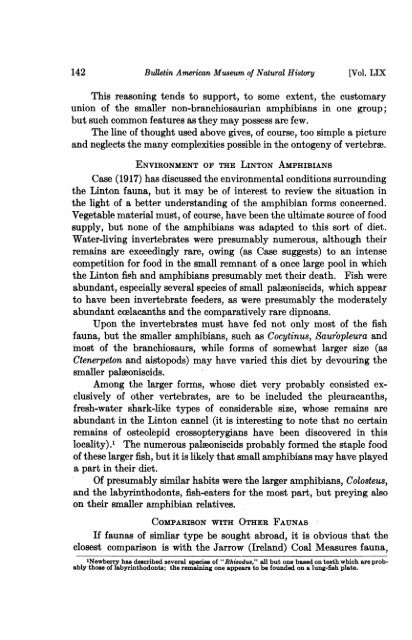View/Open - American Museum of Natural History
View/Open - American Museum of Natural History
View/Open - American Museum of Natural History
You also want an ePaper? Increase the reach of your titles
YUMPU automatically turns print PDFs into web optimized ePapers that Google loves.
142 Buletin <strong>American</strong> <strong>Museum</strong> <strong>of</strong> <strong>Natural</strong> <strong>History</strong><br />
[Vol. LIX<br />
This reasoning tends to support, to some extent, the customary<br />
union <strong>of</strong> the smaller non-branchiosaurian amphibians in one group;<br />
but such common features as they may possess are few.<br />
The line <strong>of</strong> thought used above gives, <strong>of</strong> course, too simple a picture<br />
and neglects the many complexities possible in the ontogeny <strong>of</strong> vertebrae.<br />
ENVIRONMENT OF THE LINTON AMPHIBIANS<br />
Case (1917) has discussed the environmental conditions surrounding<br />
the Linton fauna, but it may be <strong>of</strong> interest to review the situation in<br />
the light <strong>of</strong> a better understanding <strong>of</strong> the amphibian forms concerned.<br />
Vegetable material must, <strong>of</strong> course, have been the ultimate source <strong>of</strong> food<br />
supply, but none <strong>of</strong> the amphibians was adapted to this sort <strong>of</strong> diet.<br />
Water-living invertebrates were presumably numerous, although their<br />
remains are exceedingly rare, owing (as Case suggests) to an intense<br />
competition for food in the small remnant <strong>of</strong> a once large pool in which<br />
the Linton fish and amphibians presumably met their death. Fish were<br />
abundant, especially several species <strong>of</strong> small palmoniscids, which appear<br />
to have been invertebrate feeders, as were presumably the moderately<br />
abundant ccelacanths and the comparatively rare dipnoans.<br />
Upon the invertebrates must have fed not only most <strong>of</strong> the fish<br />
fauna, but the smaller amphibians, such as Cocytinus, Saurbopleura and<br />
most <strong>of</strong> the branchiosaurs, while forms <strong>of</strong> somewhat larger size (as<br />
Ctenerpeton and aistopods) may have varied this diet by devouring the<br />
smaller pa]aeoniscids.<br />
Among the larger forms, whose diet very probably consisted exclusively<br />
<strong>of</strong> other vertebrates, are to be included the pleuracanths,<br />
fresh-water shark-like types <strong>of</strong> considerable size, whose remains are<br />
abundant in the Linton cannel (it is interesting to note that no certain<br />
remains <strong>of</strong> osteolepid crossopterygians have been discovered in this<br />
locality).' The numerous palaeoniscids probably formed the staple food<br />
<strong>of</strong> these larger fish, but it is likely that small amphibians may have played<br />
a part in their diet.<br />
Of presumably similar habits were the larger amphibians, Colosteus,<br />
and the labyrinthodonts, fish-eaters for the most part, but preying also<br />
on their smaller amphibian relatives.<br />
COMPARISON WITH OTHER FAUNAS<br />
If faunas <strong>of</strong> simliar type be sought abroad, it is obvious that the<br />
closest comparison is with the Jarrow (Ireland) Coal Measures fauna,<br />
'Newberry has described several species <strong>of</strong> " Rhizodus," all but one based on teeth which are probably<br />
those <strong>of</strong> labyrinthodonts; the remaining one appears to be founded on a lung-fish plate.
















